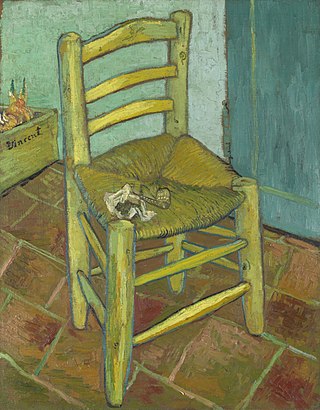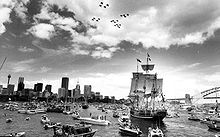
Vincent Willem van Gogh was a Dutch Post-Impressionist painter who posthumously became one of the most famous and influential figures in Western art history. In a decade, he created about 2,100 artworks, including around 860 oil paintings, most of which date from the last two years of his life. They include landscapes, still lifes, portraits and self-portraits, and are characterised by bold colours and dramatic, impulsive and expressive brushwork that contributed to the foundations of modern art. Not commercially successful in his career, he struggled with severe depression and poverty, which eventually led to his suicide at age thirty-seven.

The Starry Night is an oil-on-canvas painting by the Dutch Post-Impressionist painter Vincent van Gogh. Painted in June 1889, it depicts the view from the east-facing window of his asylum room at Saint-Rémy-de-Provence, just before sunrise, with the addition of an imaginary village. It has been in the permanent collection of the Museum of Modern Art in New York City since 1941, acquired through the Lillie P. Bliss Bequest. Widely regarded as Van Gogh's magnum opus, The Starry Night is one of the most recognizable paintings in Western art.

Café Terrace at Night is an 1888 oil painting by the Dutch artist Vincent van Gogh. It is also known as The Cafe Terrace on the Place du Forum, and, when first exhibited in 1891, was entitled Coffeehouse, in the evening.

Starry Night, commonly known as Starry Night Over the Rhône, is one of Vincent van Gogh's paintings of Arles at night. It was painted on the bank of the Rhône that was only a one or two-minute walk from the Yellow House on the Place Lamartine, which Van Gogh was renting at the time. The night sky and the effects of light at night provided the subject for some of van Gogh's more famous paintings, including Café Terrace at Night and the June, 1889, canvas from Saint-Remy, The Starry Night.
Gordon Bennett was an Australian artist of Aboriginal and Anglo-Celtic descent. Born in Monto, Queensland, Bennett was a significant figure in contemporary Indigenous Australian art.

Décoration for the Yellow House was the main project Vincent van Gogh focused on in Arles, from August 1888 until his breakdown the day before Christmas. This Décoration had no pre-defined form or size; the central idea of the Décoration grew step by step, with the progress of his work. Starting with the Sunflowers, portraits were included in the next step. Finally, mid-September 1888, the idea took shape: from this time on he concentrated on size 30 canvases, which were all meant to form part of this Décoration.
Richard Bell is an Aboriginal Australian artist and political activist. He is one of the founders of proppaNOW, a Brisbane-based Aboriginal art collective.

This is a list that shows references made to the life and work of Dutch artist Vincent van Gogh (1853–1890) in culture.
Harry James "HJ" Wedge was a Wiradjuri artist.
Kumantje Jagamara, also known as Kumantje Nelson Jagamara, Michael Minjina Nelson Tjakamarra, Michael Nelson Tjakamarra and variations, was an Aboriginal Australian painter. He was one of the most significant proponents of the Western Desert art movement, an early style of contemporary Indigenous Australian art.
Peggy Rockman Napaljarri is a Warlpiri-speaking Indigenous artist from Australia's Western Desert region. Born on what is now Tanami Downs pastoral station in the Northern Territory, she learned English when working as a child with a white mining family; Peggy Rockman and her family were subsequently relocated by government authorities to Lajamanu, a new community west of Tennant Creek. Peggy Rockman is one of the traditional owners of Tanami Downs.
Louisa Lawson Napaljarri (Pupiya) (c. 1930–2001) was a Warlpiri-speaking Indigenous artist from Australia's Western Desert region. Louisa commenced painting at Lajamanu, Northern Territory in 1986. Her work is held by the National Gallery of Victoria.
Mona Rockman Napaljarri is a Warlpiri-speaking Indigenous artist from Australia's Western Desert region. Her paintings and pottery are held in the collection of the National Gallery of Victoria.
Norah Nelson Napaljarri is a Warlpiri-speaking Aboriginal artist from Australia's Western Desert region. Norah Nelson began painting in 1986 and has exhibited her works both in Australia and other countries. Her paintings and pottery are held in the collection of the National Gallery of Victoria.
Contemporary Indigenous Australian art is the modern art work produced by Indigenous Australians, that is, Aboriginal Australians and Torres Strait Islander people. It is generally regarded as beginning in 1971 with a painting movement that started at Papunya, northwest of Alice Springs, Northern Territory, involving Aboriginal artists such as Clifford Possum Tjapaltjarri and Kaapa Tjampitjinpa, and facilitated by white Australian teacher and art worker Geoffrey Bardon. The movement spawned widespread interest across rural and remote Aboriginal Australia in creating art, while contemporary Indigenous art of a different nature also emerged in urban centres; together they have become central to Australian art. Indigenous art centres have fostered the emergence of the contemporary art movement, and as of 2010 were estimated to represent over 5000 artists, mostly in Australia's north and west.
Garry Andrews is an Australian contemporary artist.

Hospital at Arles is the subject of two paintings that Vincent van Gogh made of the hospital in which he stayed in December 1888 and again in January 1889. The hospital is located in Arles in southern France. One of the paintings is of the central garden between four buildings titled Garden of the Hospital in Arles ; the other painting is of a ward within the hospital titled Ward of the Hospital in Arles. Van Gogh also painted Portrait of Dr. Félix Rey, a portrait of his physician while in the hospital.

Van Gogh's Chair is a painting created in 1888 by Dutch artist Vincent van Gogh. It is currently held by the National Gallery, London.

The Big Easel is an installation art piece, created by Canadian artist Cameron Cross, and located in the town of Emerald in Central Queensland, Australia.













